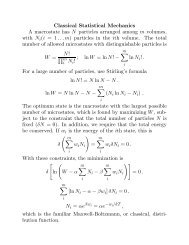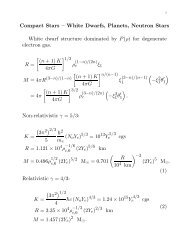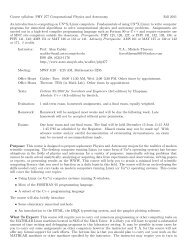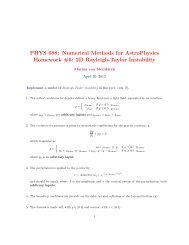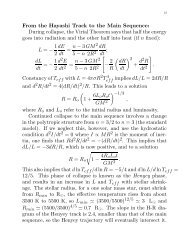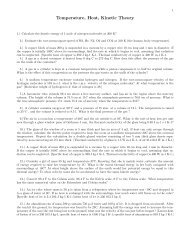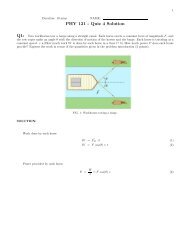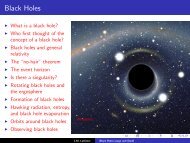Chapter 16
Chapter 16
Chapter 16
You also want an ePaper? Increase the reach of your titles
YUMPU automatically turns print PDFs into web optimized ePapers that Google loves.
Next - Saturn’s moon
Cassini Mission - July 1, 2004<br />
• 74 Orbits of Saturn<br />
• 44 close flybys of Titan<br />
• 8 close targeted flybys of<br />
other satellites<br />
• 30 additional satellite<br />
flybys at distances less<br />
than 62,100 mi<br />
• Many Saturn & Ring<br />
Occultation opportunities
4 year path of Cassini
Saturn’s Moons<br />
• Moons show less variation in properties than Jupiter’s<br />
moons, & Saturn’s ring system is more extensive:<br />
smaller mass of Saturn Lower temperature of subnebula<br />
Something else<br />
• Moons are half ice, half rock, but most have density<br />
range ~ 1.1 - 1.4 g cm -3 . The moons are smaller - less<br />
compression of ice than previously discussed icy moons<br />
• Many moons have high lunar-like crater counts
Pandora
Mimas - the “Deathstar” moon<br />
• Density = 1.2 g cm -3<br />
• Crater size = 80mi x 6 mi<br />
• Moon Diameter = 247 mi<br />
• Rotation period =0.94<br />
days<br />
• Orbital period = 0.94<br />
days
Mimas Occulting Janus
Mimas & Saturn’s Rings
Enceladus<br />
• Density = 1.1 g cm -3<br />
• Rotation period = 1.4<br />
days<br />
• Orbital period = 1.4 days<br />
• Surface: a mixture of soft<br />
craters & complex<br />
fracture terrains<br />
• terrains ~ few hundred<br />
million yr old
Enceladus - Activity<br />
• Cryovolcanism: flow of partially melted ice that mimics<br />
lava flows on silicate planets<br />
• Spray of H 2 O + ice particles observed emanating from<br />
Enceladus<br />
• Looks like Io, but Enceladus isn’t forced into non-circular<br />
orbit by companion moons like Io. What is causing this<br />
activity
Blue Streaks<br />
• Are warmer than<br />
surrounding regions,<br />
clearly indicating heatleak<br />
• It’s not clear how the heat<br />
reaches the surface
Close Approach<br />
• Boulders of ice are visible<br />
in geologically active<br />
region<br />
• Sizes ~ 30 - 330 ft in<br />
diameter
Atmosphere of Enceladus<br />
• Has been detected via an<br />
occultation of a star.<br />
• Note the asymmetry in<br />
the light curve
Saturn’s Magnetic Field & Enceladus<br />
• Saturn’s B-field is bent<br />
around Enceladus due to<br />
the interaction between<br />
particles in the moon’s<br />
atmosphere & the B-field.
Tethys<br />
• Density = 1.2 g cm -3<br />
• Orbital period = 1.9 days<br />
• Two major craters:<br />
Odysseus & Melanthius<br />
• Melanthius has an<br />
elongated mountain<br />
range instead of a central<br />
peak
Structure on its Surface<br />
• Icy land of steep cliffs<br />
• Ithaca Chasma: heavily cratered<br />
regions. Thus, cliffs are very old
Dione<br />
• Density = 1.4 g cm -3<br />
• Orbital period = 2.73<br />
days<br />
• Streaks on surface:<br />
caused by impacts or<br />
tectonic in nature
Dione & Saturn
Rhea<br />
• Density = 1.3 g cm -3<br />
• Orbital period = 4.5 days<br />
• Heavily cratered. Craters<br />
are similar in appearance<br />
to those on Moon, despite<br />
the fact that the surface is<br />
icy. Cold ice is brittle &<br />
thus less plastic in nature<br />
• Reflectivity = 60%<br />
• The high reflectivity is<br />
due to the fact that the<br />
moon has an brittle, icy<br />
surface.
Hyperion - the “Sponge” Moon<br />
• Density = 1.4 g cm -3<br />
• Orbital period = 21.3 days<br />
• Rotational period =<br />
chaotic<br />
• May have had a collision,<br />
which ripped away part of<br />
the moon & left it tumbling<br />
around Saturn<br />
• Thin layer of dark material<br />
may be covering lighter<br />
material below<br />
• Evidence of landslides
Titan<br />
Atmoshere is 90% Nitrogen +<br />
Argon, Methane & Various<br />
Hydrogen compounds<br />
(Ethane, …)<br />
• Density = 1.9 g cm -3 (!<br />
ice, ! rock)<br />
• Surface is not visible<br />
through thick clouds (thus,<br />
the need for Cassini-<br />
Huygens mission)<br />
• Pressure at Surface ~ 1.5<br />
bars<br />
• Atmosphere is 10 times<br />
more massive than<br />
Earth’s, and 10 times<br />
more extended
Atmosphere of Titan<br />
• Similar to the Earth in<br />
being mostly Nitrogen<br />
• Different from the Earth in<br />
having Methane instead<br />
of Oxygen<br />
• Low temperature keeps<br />
water frozen ! no water<br />
vapor in atmosphere<br />
• On terrestrial planets,<br />
water + carbon ! carbon<br />
compounds (e.g. CO 2 )
Atmosphere of Titan<br />
• Origin of Atmosphere<br />
1) Outgassing from icy<br />
methane & ammonia<br />
surface<br />
2) Comets<br />
• NH 3 + UV Sunlight " N + H<br />
• Hydrogen escaped, nitrogen<br />
accumulated
Spectroscopy of Titan Atmosphere<br />
• Many organic (i.e.,<br />
carbon-rich) compounds<br />
were detected by<br />
Voyager 1<br />
• Atmosphere + Charged<br />
Particles " Organic Solid<br />
(Tholin)<br />
• Tholin + Water " Amino<br />
Acid (chief component of<br />
proteins)
Pre-Cassini/Huygens Model of Titan<br />
Ethane sea may result from<br />
1) Methane + UV Sunlight<br />
" H + C<br />
2) CO 2 + hydrocarbons<br />
sink to surface<br />
3) Ethane + Methane +<br />
propane
Titan’s surface from Cassini<br />
• Narrowband infrared to<br />
see through clouds<br />
• Light & dark surfaces<br />
visible<br />
• Dark spots ! deposition<br />
of methane<br />
• Problem: methane in the<br />
atmosphere would be<br />
depleted in 10-20 million<br />
years. What process is<br />
replenishing methane
Cloud Motion in Titan’s Atmosphere
Cassini spacecraft: radar mapping of Titan (2004: Video)
Huygens Probe: a journey to the<br />
surface of Titan<br />
• Cloud layers make it difficult to study the surface in<br />
detail. The solution ! Huygens probe<br />
• After ejection from Cassini (Dec 25 2004), the probe<br />
went dormant except for timers set to end 4 hrs 23 min<br />
before atmospheric entry (January 14, 2005)<br />
• Mission: 2.5 hours during descent + several minutes on<br />
surface<br />
• Due to unknown wind speeds, the uncertainty in landing<br />
spot ~ several hundred km
Huygens Probe Descent: Animation<br />
Descent Imager & Spectral Radiometer Lamp on during descent
Huygens probe<br />
descending to Titan -<br />
Actual Images from<br />
Descent Imager<br />
Haze affects some of the<br />
images in this sequence<br />
Haze observed all the way<br />
to the ground
Descent<br />
• Bright spots ! icy, roughed<br />
• Dark spots ! flat, lowlands<br />
• Huygens landing spot ! dark
Dendritic structures & a “shoreline”<br />
• “River channels” in<br />
highlands leading to the<br />
lowland shoreline<br />
• Channels ! carved by<br />
methane rain + subsurface<br />
springs<br />
• Dark regions too extended<br />
to have been caused by<br />
river channels<br />
! Made by larger river<br />
systems<br />
! Catastrophic event
Winds & Surface Temperature<br />
• ~ 430 km hr -1 at 120 km (peak measured speed)<br />
• < 3.6 km hr -1 at surface. Are these winds sufficient to<br />
form wind-induced features on surface, or are strong<br />
gusts required<br />
• Surface temperature ~ 94 K. Sufficient for methane &<br />
ethane to be in liquid form
Huygens Landing Site<br />
• Lowlands ! “Lake<br />
bed” region<br />
• Dirty water ice<br />
• Vapors from landing<br />
produced methane<br />
(CH 4 )<br />
• + C 6 H 6 , C 2 N 2 , CO 2 ,<br />
which are not detected<br />
in atmosphere !<br />
produced by surface<br />
chemistry<br />
• No ethane (C 2 H 6 )
Huygens Landing Site: Rocks<br />
• Rock sizes: 3mm - 15 cm<br />
(0.1 - 5 inches)<br />
• No meter-size (3.3 ft) rocks<br />
seen within 40x35m of<br />
landing site during descent<br />
• Most rocks 5 cm<br />
! Large rocks can’t be<br />
transported in lake bed<br />
! Small pebbles removed<br />
from surface
Earth - Titan Surface Comparison<br />
Earth<br />
Liquid water<br />
Silicate rocks<br />
dirt<br />
Titan<br />
Liquid methane<br />
Frozen water ice<br />
Hydrocarbon particles<br />
settling out of atmosphere
Sky from the Surface of Titan<br />
• Orange in color due to the attenuation of blue light by<br />
haze relative to red<br />
• Noon Sun ! 10 times smaller in size than the Sun as<br />
seen from Earth. Brightness & size are similar to car<br />
headlight seen from <strong>16</strong>0 yards away<br />
• When the Sun is low in the sky, it is not visible.
Triton – a satellite of Neptune<br />
• Density = 2.0 g cm -3<br />
• Orbit: moves in direction<br />
opposite Neptune’s<br />
rotation<br />
" I.e., irregular satellite<br />
" It is likely a captured<br />
Kuiper belt object
Triton Surface<br />
• Methane ice + Nitrogen<br />
(& CO, CO 2 )<br />
• Pinkish color: organic<br />
compounds produced via<br />
chemical reactions of<br />
surface<br />
• Very small impact crater<br />
density = young surface
(3)<br />
Triton Terrains<br />
(2)<br />
(1)<br />
1) Southern hemisphere:<br />
flat plains covered with<br />
dark spots<br />
2) Latitudes above<br />
equator: smooth,<br />
uniform material with<br />
uniform tint<br />
3) Higher latitudes: rough<br />
terrain crossed by long<br />
grooves (“Cantaloupe<br />
Terrain”)
Triton Atmosphere: Nitrogen + some<br />
Methane



